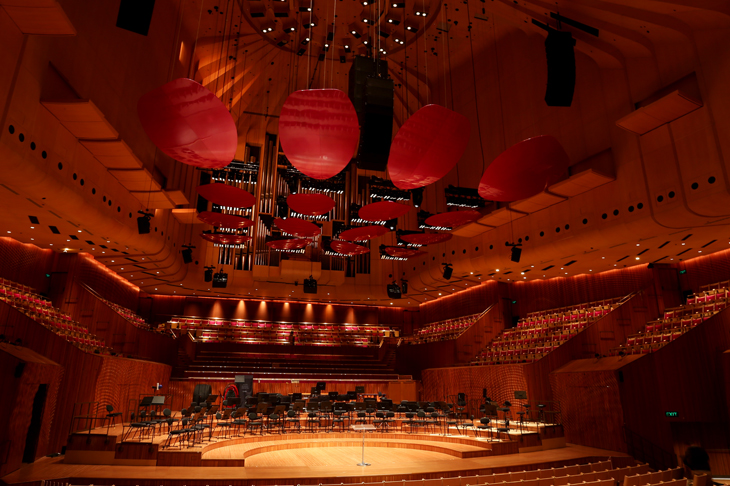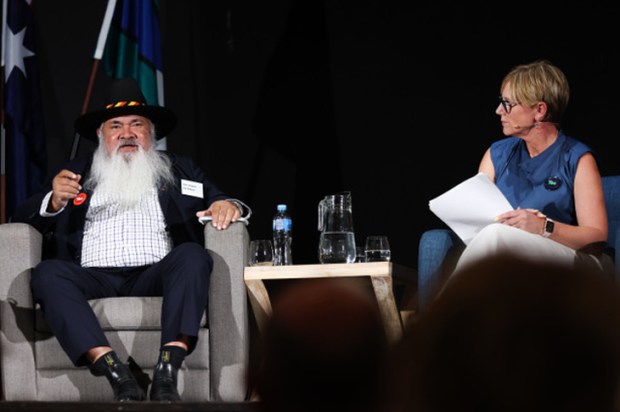‘Function is not a dirty word’. This was the challenge – carrying a clear declaration of intent – by the viciously maligned architect, the late Peter Hall, when, in 1966, he and his team of local architects replaced Joern Utzon to complete the half-built sculptural masterpiece (but by then a functional question mark), the now world-renowned Sydney Opera House. Last month, more than half a century later, Halls’ pragmatic vision of a fit-for-purpose world-class building where function was no longer subservient to its form, finally became reality. The Sydney Symphony Orchestra tested the two-and-a-half year $150 million renovation of the building’s centrepiece, the concert hall, and found it, as did its enthusiastic audiences, an acoustic masterpiece. And significant upgrades and changes resulting from lessons learned after almost 50 years’ use have made the venue far more user-friendly – especially for the SSO’s ageing audiences.
What had been a widely criticised venue for orchestral music due to patchy acoustics, is now acclaimed by the orchestra’s musicians as among the world’s best. And the concert hall’s sound can now be varied, due to techniques not available when it was completed almost 50 years ago, to accommodate a wide range of events, including vocalists and choral performances – and contemporary popular music. And later this year there will even be a staged opera – Beethoven’s Fidelio. As architect John Rourke, a spokesman for OpusSOH (made up of those who worked in Hall’s Opera House team and other supporters of a campaign to give Hall appropriate recognition within the building), said last week, ‘On Joern Utzon’s departure we were asked to turn a multifunctional hall (for both opera and orchestral concerts) into a symphony hall. Now we’ve gone the other way – back to the original design brief… made possible by technology that did not exist when they worked on the building in the 1960s.’
The new technology has certainly been well and truly tested. In just over five weeks from 20 July’s triumphant re-opening performance of Mahler’s mighty 2nd Symphony, with its large choir to last Saturday’s dual-discipline acting-orchestral performance (a collaboration with Belvoir St. Theatre) of Mendelssohn’s (and Shakespeare’s) Midsummer Night’s Dream, the SSO has given the new acoustics a wide-ranging (and unprecedented) series of 22 testing concerts – an average of four a week. All have been major works, like Brahms’ choral-backed German Requiem, two violin concertos, a Tchaikovsky and two Beethoven symphonies and a Beethoven piano concerto with critics’ reviews universally praising the clarity of the sound. All but four have been conducted by the SSO’s new chief Conductor Australian maestro Simone Young to universal critical and audience acclaim.
These improvements will be internationally tested on 2 September, with a concert by the highly-rated Australian World Orchestra (made up of distinguished Australians in leading orchestras worldwide) under renowned conductor Zubin Mehta.
There is little disagreement that the acoustics needed upgrading; musicians could not hear each other clearly, let alone audiences in some parts of the hall. Now they can. But in a recent SMH article, Helen Pitt wrote that Peter Hall was not to blame for the acoustical problems, and that ‘none of the building’s previous defects were Hall’s fault’, while noting that the new changes had left Hall’s basic interior design remaining the same.
Utzon’s forced resignation in 1966 was over his failure to provide the engineers, Ove Arup, with needed working drawings after years of delays and cost over-runs. Hall’s task was not only to provide the working drawings to complete the building but also to make it fit for purpose. As he wrote at the time, ‘The idea was there, the broad aesthetics were taken care of. But with the requirements of the major user not met, the same could not be said for its functions… [Hall proposed] to complete the building so that it would work’ – and that involves having good acoustics.
Utzon had never resolved the conflicting demands of the chaotic government-appointed committee that was ‘the client’; his (acoustically impossible) planned dual-purpose hall went nowhere near meeting the requirements of the brief when, in 1956, his magnificent conceptual sketch won a competition to build a cultural centre on Sydney’s Bennelong Point. But by the time he left the project his outlines indicated there was no way he could meet the main hall seating requirement of 3,000 to 3,500 people. And there was no clear priority for the needs of orchestral concerts to be paramount in what was, misleadingly, named the Sydney Opera House. But the brief was clear and unambiguous with the building’s purposes, in order of priority, to be: 1. symphony concerts 2. large-scale opera 3. ballet and dance 4. choral/pageants/mass meetings.
Not everyone is happy with the changes. Some members of Peter Hall’s family have expressed disappointment at acoustic-prompted changes to the appearance of the concert hall walls, even though his basic design remains. And Dr. Anne Watson, who has written a detailed book on the completion of the Opera House, questions the architectural price of ideal acoustics in a letter to the SMH that appears contrary to Hall’s pragmatic pursuit of functionality. ‘Hall’s interior was designated of “exceptional” significance in the 2017 Sydney Opera House Conservation Management Plan which noted that “any changes must retain and respect… the form, quality and character” of Hall’s design. The visually awkward and intrusive new changes may meet modern requirements for acoustic flexibility but they have been at the expense of the integrity, elegance and heritage significance of the original interior. Hall’s children have every right to be “upset”. The alterations to Hall’s most significant performance space lend even more weight to the call for recognition of his contribution to the Opera House in the renaming of the current Playhouse, one of Hall’s favourite small theatres, to the Peter Hall Playhouse.’
While Utzon’s status is acknowledged in the Utzon recital room, the failure to recognise Hall and his team’s central role in a building which, as completed by them, is of world heritage fame, is a disgrace.
Got something to add? Join the discussion and comment below.
Get 10 issues for just $10
Subscribe to The Spectator Australia today for the next 10 magazine issues, plus full online access, for just $10.
You might disagree with half of it, but you’ll enjoy reading all of it. Try your first month for free, then just $2 a week for the remainder of your first year.














Comments
Don't miss out
Join the conversation with other Spectator Australia readers. Subscribe to leave a comment.
SUBSCRIBEAlready a subscriber? Log in